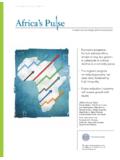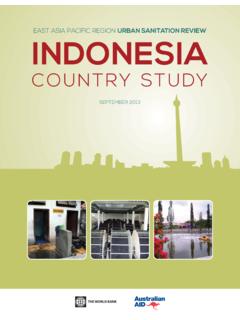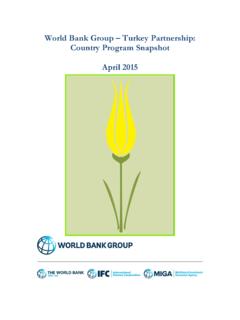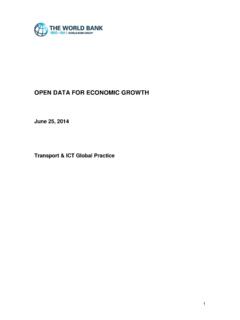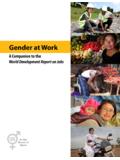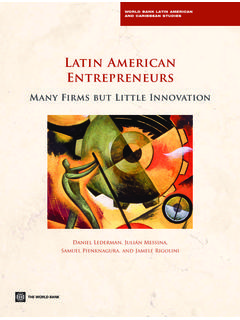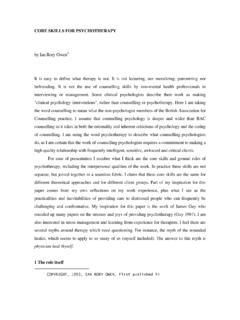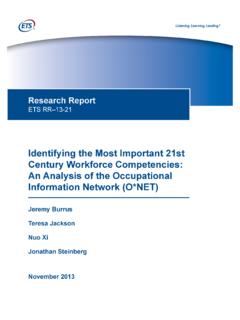Transcription of World Bank Document
1 Dysfunctions of the Labor Market 05 The labor code paradoxically contributes to exploitation of workers and job insecurity170134567892074I05I9ntIrod0uIc ouit9 IThe Tunisian labor market is characterized by deep dysfunctions, which have contributed to keep the economy in low productive activities and generate mainly low-quality, insecure jobs. Tunisia s economy needs to create more jobs in particular there is a need for skilled jobs to employ the growing number of university graduates. The growing graduate unemployment over the past decade reflects the structural mismatch between the increasingly skilled labor force and an economy that has remained stuck in low productive activities (as discussed in Chapter One). Available jobs have been of low quality, both in terms of value added (and therefore pay) and also in terms of low job security.
2 In fact, jobs have increasingly been informal or in fixed-term contracts, which entail no workers protection, and have translated into an overly high level of turnover in its worst manifestations, notably those linked to the infamous working arrangements often associated with outsourcing to Tunisia of assembly activities, this economic system has allowed the exploitation of workers which Tunisians refer to as the phenomenon of the sous-traitance. The resulting large rates of unemployment and informality, as well as high mismatch and underemployment, underpin the great social discontent that has been violently expressed by Tunisia s youth. These outcomes are in part the result of the policies regulating the labor market in Tunisia. As discussed in previous chapters, the weak economic performance and insufficient and low-quality jobs creation is the result of an economic environment permeated by distortions, barriers to competition, and excessive red tape, resulting in low productivity and pervasive rent-extraction for cronies.
3 Nevertheless, while labor market policies do not appear to be the key constraint to jobs creation in Tunisia, this chapter argues that the creation of good quality jobs is exacerbated by the policies regulating the labor market in Tunisia and the distortions introduced by the labor code, the social insurance system, and the wage negotiation mechanisms. The social insurance system in Tunisia fails to protect workers and exacerbates unemployment. Labor regulations and institutions in Tunisia promote job insecurity and the bias toward low-skill jobs. The chapter shows that the rules and institutions regulating the labor markets in Tunisia, while introduced with the best possible intentions, are in fact counterproductive, as the mix of rigidity and flexibility has hindered investment in higher value added activities and innovation, while resulting in abusive types of labor arrangements.
4 In no small way, hence, the labor code, the social insurance system, and the wage negotiation mechanisms in Tunisia today contribute to create and perpetuate inequities, especially for chapter discusses how to enable faster and better quality jobs creation, while ensuring better protection for the unemployed. The chapter starts by highlighting the shortcomings that characterize the Tunisian labor market in terms of insufficient and low-quality jobs creation, as well as the increasing skills mismatches and patterns of high labor mobility. It then discusses the system of social insurance, labor regulations and institutions, and the role of the public sector, highlighting the way in which these have distorted labor markets outcomes and resulted in greater, not lower, of the Labor / A labor market Characterized by low-quality and Insecure Jobs The Tunisian labor market is characterized by a significant amount of mismatch , notably a surplus of skilled labor and a shortage of unskilled and semi-skilled ones.
5 To quantify skills mismatches in the economy, one can compare the new jobs created by the economy by occupation with the occupation declared by the stock of unemployed 1. The results indicate that unskilled and semi-skilled (manual and non-manual) workers in Tunisia are in shortage, while technicians and professionals are in surplus (figure ) 2. Obviously, at present there is no shortage of unskilled and semi-skilled labor in Tunisia, and there will not be one in the near future. What the chart is meant to show, however, is that there is a skills mismatch : the occupational structure of unemployment is different from that of employment or jobs being created (that is, labor demand). This implies that there will be unemployment (structural) even if the economy creates more jobs.
6 In particular, there still will be excess supply of highly educated workers, because currently the economy demands mostly less skilled manual labor 3. Not only there are few jobs for skilled workers but the quality of available jobs also remains low and informal employment is wide spread in Tunisia. About half of all wage earners (45 percent) work without an employment contract. Not surprisingly, informality rates are higher among younger and less educated individuals4. The large majority of all employed individuals (about 64 percent) are either informal wage earner or self-employed (figure ). Formal employment accounts for only 36 percent of overall employment, and the public sector remains the main source of formal employment in Tunisia5. Only 14 percent of all employed individuals are so in the private formal sector, which traditionally is considered as the high-productivity sector as a comparison, this share oscillates between 20 and 40 percent in middle-income countries in Europe and Central Asia (ECA) and Latin America ( World bank 2013a)6.
7 In addition, most of these workers have fixed-term contracts (which, as will be explained below, in Tunisia are necessarily also short-term contracts), and this type of contract in Tunisia entails no job security7. Figure : Labor Surplus and Shortages by Occupation in Tunisia, 2011 UnskilledOperatorsCraftSalesClerksTechni ciansProfessionals-60-40-20020406053390% of new jobs that cannot not be taken by unemployed with same occupation% of job losers who will not find new jobs in their occupation-21-27-400 ShortageSurplusSource: Authors calculations using the Tunisia 2011 Labor Force Survey 172134567892074I05I9ntIrod0uIcouit9 IFigure : Work Status of Employed Individuals in 2010 Figure : Transitions of the Employed Population Between 2010 and 2011 Self-employed (Q4 2010)Informal (Q4 2010)Public sector (Q4 2010)Formal private sector (Q4 2010)02040608010018,382,6 Source: Authors calculations using Tunisia s 2010 Labor Force SurveySource.
8 Authors calculations using Tunisia s 2010 and 2011 Labor Force SurveysEmployed in the formal sector (Q4 2010)34%Private Informal wage30%Self Employed& unpaid22%Public14%Private FormalLabor mobility in and out of joblessness is significant, signaling that available jobs have relatively short duration and result in a high rate of jobs turnover and more generally reflecting the precarious nature of employment in Tunisia 8. As indicated by table , mobility in and out of joblessness during the period of study was limited. Only about a third of all individuals unemployed in year 2010 found a job in year 2011, while almost two-thirds of the unemployed remained unemployed or become inactive in 2011. In fact it is concerning that more than half of all individuals unemployed in 2010 became inactive in 2011, suggesting high rates of discouragement that is, many unemployed opted out of the labor force.
9 The majority of individuals employed in 2010 remained employed in 2011; only a minority became unemployed ( percent) and percent entered into inactivity, many of which could be new retirees. Inactivity was somehow stickier, as 81 percent of those individuals inactive in 2010 remained inactive in 2011. Only percent of all inactive in 2010 found employment in 2011. Workers with fixed-term contracts are more mobile. As expected, workers with fixed-term contracts display higher patterns of mobility than workers with open-ended contracts (table ). About 25 percent of all workers who had a fixed-term contract in 2010 became informal in 2011 9. This observation may have been driven by the adjustments in private sector employment in response to the economic shock after the January 2011 revolution, but as discussed below also reflects a deeper dysfunction with the use of fixed-term contracts.
10 As expected, mobility across contract types was less pronounced among workers with open-ended contracts. Surprisingly they are also more mobile than workers with no contract, however. A significant share of informal workers in 2010 became formally employed in 2011 ( percent obtained fixed-term contracts and percent an open-ended contract). Results using the Tunisia graduate tracer survey (2004-2008) confirm the mobility patterns identified above (for details see DPR background report on "Creating Good Jobs in Tunisia", World bank 2014c)The very high mobility is symptomatic of the dysfunction of the Tunisian labor market, which has resulted in exploitative forms of labor. While the high mobility registered in 2010-2011 partially reflects adjustments following the economic shock in early 2011, in fact it is largely symptomatic 12,193,0173134567897923405I4ntr619t7 Table : Transition Matrix: Change in Employment Status of Workforce (aged 15-64) Between 2010 and 2011 Table : Transition Matrix: Change in Type of Contract Between 2010 and 2011of a deeper dysfunction affecting the Tunisian labor market, which is known in Tunisia as the phenomenon of the sous-traitance.

